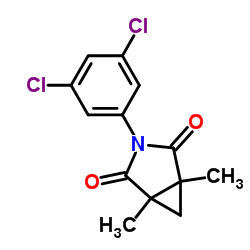Procymidone

Procymidone structure
|
Common Name | Procymidone | ||
|---|---|---|---|---|
| CAS Number | 32809-16-8 | Molecular Weight | 284.138 | |
| Density | 1.5±0.1 g/cm3 | Boiling Point | 477.9±35.0 °C at 760 mmHg | |
| Molecular Formula | C13H11Cl2NO2 | Melting Point | 166-167°C | |
| MSDS | Chinese USA | Flash Point | 242.8±25.9 °C | |
|
Determination of pesticides in sunflower seeds by high-performance liquid chromatography coupled with a diode array detector.
J. AOAC Int. 97(4) , 1012-20, (2014) The application of RP-HPLC with a diode array detector for identification and quantitative analysis of pesticides in sunflower seed samples is demonstrated. An HPLC procedure on C18 RP column has been developed for analysis of selected pesticides from differe... |
|
|
Assessment of estrogenic and anti-androgenic activities of the mycotoxin zearalenone and its metabolites using in vitro receptor-specific bioassays.
Food Chem. Toxicol. 74 , 233-9, (2015) Zearalenone (ZEN) is a well-known mycotoxin present in numerous agricultural products. Humans and animals are therefore at a risk of exposure to zearalenone through consumption of contaminated food. After intake, ZEN is reduced to α- and β-zearalenol (α-ZEL a... |
|
|
A multi-lysimeter investigation on the mobility and persistence of pesticides in the loam soil of the Fucino Plain (Italy).
J. Environ. Monit. 10(6) , 747-52, (2008) In order to evaluate the impact of intensive horticulture on the water resources of the Fucino Plain, one of the most important agricultural settlements of Central Italy, the mobility and persistence in the soil of five commonly used pesticides was investigat... |
|
|
Persistent developmental toxicity in rat offspring after low dose exposure to a mixture of endocrine disrupting pesticides.
Reprod. Toxicol. 34(2) , 237-50, (2012) There is growing concern of permanent damage to the endocrine and nervous systems after developmental exposure to endocrine disrupting chemicals. In this study the permanent reproductive and neurobehavioral effects of combined exposure to five endocrine disru... |
|
|
Combined exposure to endocrine disrupting pesticides impairs parturition, causes pup mortality and affects sexual differentiation in rats.
Int. J. Androl. 33(2) , 434-42, (2010) Risk assessment is currently based on the no observed adverse effect levels (NOAELs) for single compounds. Humans are exposed to a mixture of chemicals and recent studies in our laboratory have shown that combined exposure to endocrine disrupters can cause ad... |
|
|
Pesticide residues in tomatoes from greenhouses in Souss Massa Valley, Morocco.
Bull. Environ. Contam. Toxicol. 88(3) , 358-61, (2012) Eight pesticide residues in tomato samples collected in the area of Souss Massa Valley (Southern Morocco) were analyzed. The detected residue levels ranged from 0.001 to 0.400 mg kg(-1) for dicofol, from 0.003 to 0.170 mg kg(-1) for procymidone, from 0.001 to... |
|
|
Pesticide residues in berries harvested from South-Eastern Poland (2009-2011).
Rocz. Panstw. Zakl. Hig. 64(1) , 25-9, (2013) Poland is a leading grower/producer of berries in Europe that are either eaten raw or processed. As well as berries this includes fruit such as grapes, strawberries and other small fruits. Testing for the presence of active substances in Plant Protection Prod... |
|
|
[Occurrence of pesticide residues in raspberries in 2000-2005].
Rocz. Panstw. Zakl. Hig. 58(3) , 509-13, (2007) The aim of this paper was to present occurrence of pesticide residues in raspberries in 2000-2005. Gas chromatographic and spectroscopy methods were used. The most frequently found were tolylfluanid residues (43% of the analysed samples), procymidone residues... |
|
|
Modelling the dissipation kinetics of six commonly used pesticides in two contrasting soils of New Zealand.
J. Environ. Sci. Health B 44(6) , 507-17, (2009) We used three non-linear bi-phasic models, bi-exponential (BEXP), first-order double exponential decay (FODED), and first-order two-compartment (FOTC), to fit the measured degradation data for six commonly used pesticides (atrazine, terbuthylazine, bromacil, ... |
|
|
[Occurrence of plant protection product residues in apples in 2007].
Rocz. Panstw. Zakl. Hig. 59(3) , 293-300, (2008) The aim of this paper was to present occurrence of plant protection product residues in apples in 2007. Gas chromatographic and spectroscopy methods were used. The most frequently found were fungicides: dithiocarbamate residues (18% of the analysed samples), ... |